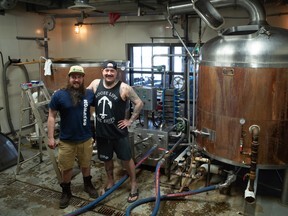Victoria Fox's Blog, page 102
April 18, 2024
Sauce Magazine – Gerard Craft’s Expat BBQ hosts pop-up ahead of opening at City Foundry STL later this year
Written by Lauren Healy // April 18, 2024
Expat Barbecue, a new globally inspired concept from Gerald Craft’s Niche Food Group, is scheduled to open later this year at Midtown’s City Foundry STL and will host a series of events this spring. Let’s get a taste of what to expect at the pop-up. The event will be held at the Urban Chestnut Midtown Brewery and Beer Garden, 3229 Washington Ave., where Niche’s Brass Burger currently operates.
The Expat BBQ menu includes dishes created by Executive Chef Sam Nawrocki and his team, utilizing American barbecue techniques in a variety of cuisines from around the world.All pop-ups start at 11am
Saturday, April 20th
St. Louis-style ribs are rubbed with house-made Five Spice, smoked for five hours, drizzled with Hakuju Whiskey BBQ sauce, and topped with chili crisps.
Saturday, May 4th
The event will feature brisket sandwiches with adobo-filled chipotle, avocado salsa verde and cilantro, and will coincide with the first day of the Beer Garden’s Maifest celebration, which includes live music and the release of UCBC’s Maibock beer. As part of our annual “Raise a Pint for Pets” campaign in partnership with Purina, bring your dog to the beer garden for the day and sample Urban’s Underdog His Lager special beer on draft.
Sunday, May 26th
The final event in the series will feature a pulled pork sandwich with Vietnamese “hogwash,” pickled ginger, and Thai basil.
Plus, at two upcoming events, you’ll get a preview of one of Niche’s other upcoming concepts: the return of Porano in Des Peres. Try the pasta dishes at Nudo House (11423 Olive Blvd) in Creve Coeur. Sunday, April 21st, 11 a.m. to 3 p.m. The full menu will be unveiled at Wild Carrot, 3901 Shaw Blvd. Sunday, June 2 from noon to 6:30 p.m. in St. Louis.
The post Sauce Magazine – Gerard Craft’s Expat BBQ hosts pop-up ahead of opening at City Foundry STL later this year appeared first on Vctoria Fox.
Fort McMurray Brewery is reviving craft beer by sticking to the basics
breadcrumb trail link
news local news
“We’re just a bunch of working people who like beer,” says Drum Brewing’s Trevor Wakeling.
Published April 18, 2024 • 2 minute read
 LR: Albert Forsey and Trevor Wakeling take a break from brewing at Drum Brewing on April 11, 2024.Vincent McDermott/Fort McMurray Today/Postmedia Network
LR: Albert Forsey and Trevor Wakeling take a break from brewing at Drum Brewing on April 11, 2024.Vincent McDermott/Fort McMurray Today/Postmedia Network
On Wednesday mornings, Trevor Wakeling and his friend Albert Forsey inspect giant vats of malt and yeast goo, stirring them with the paddles of their canoes. After passing through a network of tubes and tanks, the granular soup ferments over several weeks into different styles of beer.
Advertisement 2
This ad has not yet loaded, but article continues below.
Article content
Wakeling and Forsey have been making their own beers in a homegrown setup for years. But as breweries opened across Alberta, a group of six friends became frustrated with the lack of a local beer scene in Fort McMurray. Drum Brewing was born in a location with a unique history of catering to local craft beer cravings.
Article content
“We’re just a bunch of working people who like beer,” Wakeling said. “What brought us all together was that we loved drinking beer together.”
Drum Brewing’s location on Franklin Avenue is the latest effort to create a craft beer culture in Fort McMurray.
The brewing equipment is leftover from Wood Buffalo Brewing Company, which operated from 2013 to 2019. He was familiar with this equipment as he had been brewing beer at the restaurant 57 North, which opened after his original brewery closed.
Advertisement 3
This ad has not yet loaded, but article continues below.
Article content
Although the equipment is larger than a homebrewing kit, the steps of mashing, boiling, fermenting, carbonating, and drinking are the same.
 Trevor Wakeling stirs the mash that will ferment into beer at Drum Brewing on April 11, 2024.Vincent McDermott/Fort McMurray Today/Postmedia Network
Trevor Wakeling stirs the mash that will ferment into beer at Drum Brewing on April 11, 2024.Vincent McDermott/Fort McMurray Today/Postmedia Network
After 57 North closed in May 2022, Wakeling purchased the space in July 2023 with partners Matt Nash, Ryan Reid, Jeff Mahood, Kayla Wakeling and Paige Pakalovski. None of them have ever run a brewery and all have full-time jobs outside of Drum Brewing. Wakeling and Forsey are mechanics. The doors opened in October last year.
The original owners of Wood Buffalo Brewing Company chose this location because an arena was planned for downtown. Although it got off to a strong start, it never recovered from the collapse in global oil prices at the end of 2014 and the destruction of the arena by Congress in 2015. 57 North has struggled during the COVID-19 pandemic and after the April 2020 floods.
Advertisement 4
This ad has not yet loaded, but article continues below.
Article content
Before anyone says the space is cursed for brewers, Wakeling says the owners run a different business than previous tenants.
The layout is about one-fifth the space of the previous tenant. Wakeling says this will allow the brewery to focus on taproom culture and making beer locally. The previous tenant was “a restaurant with a brewery attached,” Forsey said.
“The other locations never got crowded enough to fill 200 seats. And we go to a lot of breweries and taprooms, which usually seat about 40 people at most.” said Mr. Wakeling. “It would have been better if the arena had been held, if there had been a restaurant.”
Drum Brewing hopes to debut the beer at various craft beer festivals across Alberta next year. Travel Alberta estimates that more than 170 breweries have opened across the province in recent years. Most are in Calgary, but there are local breweries everywhere from Waterton and Fort MacLeod to Cold Lake and Peace River.
Locally, the brewery partners with community organizations, sporting events, and other businesses. They’ve hosted trivia, paint nights, and even beer yoga. The owners talk about the brewery’s atmosphere, but agree that the focus has always been on locally produced beer.
Sign up for our newsletter to get Fort McMurray Wood Buffalo news and events delivered to your inbox every Friday morning.
vmcdermott@postmedia.com
Article content
Share this article on your social networks
The post Fort McMurray Brewery is reviving craft beer by sticking to the basics appeared first on Vctoria Fox.
Dedication to the craft | The Daily World
Clarks Restaurant has flourished because of hard work, familial ties, and a dedication to keeping the food quality the same — delicious.
Just try the milkshake, double dog dare you.
The high standard Kathy Kalkwarf, who owns the restaurant, has kept the restaurant close to the hearts and stomachs of its longtime customers for the past 26 years. Clarks is open seven days per week, from 10 a.m. to 7 p.m. They serve via dine-in, take-out — there’s a drive up window, or outside seating.
After Kalkwarf and her late-husband Rich bought Clarks Restaurant in 1997, they got to work on some serious renovations. They worked through the winter and then opened during Memorial Weekend of 1998.
“When we renovated, we put the whole neighborhood to work,” Kalkwarf said as she named a couple of the workers involved. “All these neighbors who could do plumbing, (electrical). … We tried to put all local people to work doing this. It was in such bad shape.”
Not taking the easy route
To this day, Clarks Restaurant — 731 U.S. Highway 101 — makes its own food. And they do it with local people. Kalkwarf doesn’t cut corners to make tasks, or recipes easier. She pointed to one of the breakfasts for which the restaurant is known.
“We make our own biscuits and gravy,” Kalkwarf said of one of the near countless homemade menu items. “We just have simple recipes.”
Some people think what makes a restaurant successful is a bunch of fancy tricks, but sometimes all people want is a comfortable place where they know they can get good food. It seems Clarks is the latter. When Kalkwarf isn’t working on her famous, homemade pies, she comes for the Reuben sandwich and the potato salad as a treat.
“I’ve had a lot of people tell me it’s the best Reuben they’ve ever eaten,” Kalkwarf said.
One table full of hungry customers said how they visit Clarks once per week and sometimes twice a week. They said how they’ve tried just about everything on the menu, and how they’ll keep coming back.
With those milkshakes, how can anyone deny themselves a trip back? And if milkshakes or a wide selection of pop aren’t your thing, they also sell local craft beer such as Steam Donkey Brewing Co., out of Aberdeen, and wine.
Given Kalkwarf’s resistance to changing the way Clarks Restaurant operates, it seems those long-time customers will keep returning. And they’ll bring their friends. The staff is partially made up of the happy, young customers who grew up, which shows the community’s appreciation for Clarks. And judging by a recent lunch rush, the restaurant is doing just fine.
Clarks Restaurant succeeded through tougher times too.
The restaurant survived the COVID-19 pandemic. When the restaurant had to stop its in-seat dining, Kalkwarf added a “carhop” element to the restaurant. She remembered announcing on Facebook how the restaurant was staying open with that new element. She said the restaurant got 26,000 “hits,” which she said referred to the shares, likes, loves, etc. … And like the Facebook post, Clarks was a hit, even during the pandemic.
Kalkwarf talked about what makes Clarks Restaurant a place to drive to. It’s in the unincorporated Artic neighborhood, which is six miles south of Aberdeen and a few miles south of Cosmopolis. And it’s easy to spot just off the winding U.S. Highway 101 South.
More keys to success
“We don’t scrimp on anything,” Kalkwarf said. “When the prices started going up on the product and everything, we chose to scale up our prices accordingly. The old prices kind of went out the door because the cost went so high. But, if you notice at other places their burgers (shrunk). Everything shrank. We refused to do that. Our product is the same today as the day we opened in 1998.”
The level of detail Kalkwarf and her small crew of servers and grill cooks puts into the restaurant is admirable.
Kalkwarf, who earned her business degree years ago, knew when she started that the restaurant business was a tough nut to crack. She said one statistic that has stuck in her head since then is the industry, at that point, had an 85% failure rate. And now, after 26 years of being open, she’s still doing what she can to make sure Clarks keeps pressing its lean ground chuck burgers, making its homemade ice cream, flavoring its popular clam chowder and the “Kathy’s Special Veggie Salad” for many more years. This is her formula for success and it’s worked, so why change it?
And the work didn’t start with cooking the meals, serving the frosty chocolate milkshakes, making the ice cream from scratch, nor did it start with the fun chats with customers.
“It needed so much work,” Kalkwarf said about renovating Clarks through the winter months in 1997. “We have pictures over there. There’s a whole book because the first couple of months after we bought it, Rich was still in L.A. I was sending him pictures of the restaurant as people were working on it and what it was like. You could see how bad it was.”
The work included the exterior, the interior walls, the flooring, cleaning with a lot of Simple Green All-Purpose Cleaner, and just making the place better.
“We had to dig a well, here’s Pete Smith, the well-digger,” Kalkwarf said. “Everybody said ‘oh you can’t get water there,’ but he did. This is what the floor used to look like. The challenge was bringing it back to life without changing it. You understand what I mean?”
Kalkwarf talked about an experience at a hardware store when she and Rich argued about the lighting. He wanted newer, fancier technology to light the place. She said ‘No,’ and they left frustrated with each other over the issue. But she was right.
“The day that we opened and the people walked through the door and looked around, they said ‘Oh good, it’s the same.’ Why? Because those lights were still there,” Kalkwarf said. “At that point, (Rich) understood how important those lights were. It’s those little things. Just like we didn’t change the paneling, but we sure used a lot of Simple Green on it.”
But Clarks Restaurant wasn’t always Kathy’s place. It started in the Artic neighborhood in 1923 as a gas station, tavern and grocery store, according to the restaurant website. Back then Clarks was known for their “memorable Friday night dinners — especially with their homemade ice cream.” It’s what Kalkwarf, who worked at Clarks as a potato peeler for one year when the original owners ran the establishment, is proud to continue to bring the area.
She couldn’t do it without her staff
“I just have the best people, I kind of adopt them,” Kalkwarf said. “My daughter works for me. … I have my grandson that works. I have another grandson who works too. … And I’ve got Andrea (Plummer) who’s here. She’s worked for me for like 14 years. She was a neighbor girl.”
Kalkwarf said she hires the people who live near Clarks.
“The kids who go to North River get the first whack at a job,” Kalkwarf said. “I try to fill with them. Debbie lives right down at the Artic Park. Andrea’s parents still live out here, but she lives just over the hill in Cosi.”
And now, Kalkwarf hires the children of former staff and the people who ate at Clarks as kids.
Staff comments
Plummer talked about working at Clarks.
“I think it’s really amazing,” Plummer said. “I grew up like five minutes that way. They’ve known me since I was like knee-high. I started working here when I was about 21 and I am 36 now. It’s been a good 15 years. I love it.”
Plummer said she’s “met a lot of good people here,” including people from “way back” with whom she’s been able to keep in touch.
As a recommendation, Plummer sold Clarks’ peanut butter milkshake and their Reuben sandwich.
Extended family affair
Despite various roadblocks, deaths of beloved staff and family members, paying off the renovation costs, surviving the pandemic, and fighting through the changing economy that’s making supplying the restaurant harder, Kalkwarf is still enjoying what she does, especially since she loves her customers. That’s not a cliché.
“My longtime customers are family too,” Kalkwarf said. “There have been many, many customers who I’ve gone to their funeral. That’s how I feel about my customers. And my crew feels that way too. You get attached to your customers and I thank them, every single one of them.”
Kalkwarf talked about the “helicopter lady,” Natalie, who was a flight nurse from Harborview Hospital. She flew from Harborview to Alaska for 30 years.
“They’ve been coming here for the (entire) 25 years,” Kalkwarf said. “Whenever there was an issue with my parents, or whoever, then I call her. ‘(Hey) Natalie, what about this?’”
And it sounded like the customers relate to Kalkwarf and her staff the same way, even staying at a hospital with Kalkwarf’s family during a tough time.
“We love our customers, we love our customers,” Kalkwarf said. “We care about them a great deal, every one of them.”
James Covault, who was making a bacon cheeseburger at the time, summed up the main reason for Clarks’ success in its small area of Grays Harbor County.
“It’s a real community out here,” Covault said.
Contact Reporter Matthew N. Wells at matthew.wells@thedailyworld.com.


Matthew N. Wells / The Daily World
Kathy Kalkwarf, owner of Clarks since 1997 — it reopened in 1998, keeps a photo album full of images that show former staff, the renovations the restaurant needed when Kalkwarf and her late husband Rich bought the place, and the old way Clarks used to look.


Matthew N. Wells / The Daily World
James Covault, grill cook, seemed to be in good spirits when he gave a brief soundbite as to how it is at Clarks Restaurant. “It’s a real community here,” Covault said after he finished cooking this homemade bacon cheeseburger.


Matthew N. Wells / The Daily World
Make sure to slow down before following the simple message “Eat.” Clarks Restaurant — 731 U.S. Highway 101, six miles south of Aberdeen in the Artic neighborhood — comes up quick on the winding, hilly highway. But if you follow the message, you probably cannot go wrong. There’s a large ordering board inside that is taller than grown adults in order to show the near countless homemade menu items available.


Matthew N. Wells / The Daily World
Deborah Hughes, holding two well-stacked bacon cheeseburgers fresh off the flat-top, is one of the friendly faces at Clarks Restaurant. Kathy Kalkwarf wanted to feature her staff, which is why she’s not pictured. She knows she couldn’t have operated such a successful business without her staff.
The post Dedication to the craft | The Daily World appeared first on Vctoria Fox.
How to craft in Fallout Shelter
There’s a lot to find in the wasteland, and Fallout Shelter turns the junk you find on your quests and tours into valuable equipment and stylish themes. However, making it by hand takes time and effort. First you need to unlock the appropriate workshop and collect enough junk to craft something useful.
THEGAMER video of the day Scroll to continue with content
 Related Fallout Shelter: Achievements/Trophies Guide Are you ready for the challenge?
Related Fallout Shelter: Achievements/Trophies Guide Are you ready for the challenge?
It doesn’t have to be difficult to create, but it does require some planning. There’s a lot to consider, from collecting the junk you need to building a room suitable for crafting. We’ve detailed the purpose of each workshop and how to craft the items you need to survive in the wasteland.
How to use the weapon workshop
To unlock the weapon workshop, you need 22 residents in the vault. It requires the space of three rooms, so you’ll need to plan ahead before building.
Junk can be used to craft weapons by assigning residents to workshops. Some weapons can be crafted and found only in the wasteland.
Weapons come in three rarities: common, rare, and legendary. You can come across more common weapons, but legendary weapons do more damage. However, it takes more time and caps to create.
Weapon rarity
Required junk rarity
types of junk
amount of junk
general
general
1-3
1-5
rare
general
rare
2-3
legendary
general
rare
legendary
3
How to use the costume workshop
To unlock the Outfit Workshop, you need 30 residents in the vault. This workshop can be used to create new outfits that improve various stats for your residents. Better statistics will help them survive and increase work efficiency.
Assign a resident to the costume workshop, enter the room and select “Craft”. Choose from available items and use junk to create new clothing.
costume rarity
Required junk rarity
types of junk
amount of junk
general
general
1-3
1-5
rare
general
rare
2-3
legendary
general
rare
legendary
3
How to use theme workshops
To unlock a themed workshop, you must have at least 42 residents in the vault. You can use themes to change the look of your diner room and living quarter room.
The theme is purely cosmetic and provides no benefit other than a new look.
To create a theme, you need to complete quests and collect fragments in the wasteland. Once you have collected all the Theme Recipe Fragments, you will be able to create Theme Recipes.
Below is a table of themes available for Fallout Shelter.
theme
junk you need
Brotherhood of Steel Diner
Brotherhood of Steel Quarters
Baseball Glove (6) Alarm Clock (6) Toy Car (6) Shovel (5) Teddy Bear (4) Baseball Glove (5) Alarm Clock (5) Toy Car (4) Shovel (4) Teddy Bear (3)
institute diner
Institute living quarters
Tabletop fan (6) Duct tape (5) Thread (5) Camera (4) Microscope (4) Tabletop fan (8) Duct tape (7) Thread (7) Camera (5) Microscope (6)
minutemen diner
Minutemen living quarters
Toy car (2) Duct tape (1) String (1) Brahmin skin (1) Shovel (1) Toy car (3) Duct tape (2) String (3) Brahmin skin (2) Shovel (2)
railroad diner
Railway residential area
Baseball glove (4) Globe (3) Table fan (4) Magnifying glass (4) Wonder glue (3) Baseball glove (2) Globe (2) Table fan (2) Magnifying glass (2) Wonder glue (1)
party diner
party living quarters
Toy car (2) Brahmin skin (1) Duct tape (1) Shovel (1) String (1) Toy car (3) Brahmin skin (3) Duct tape (2) Shovel (2) String (2)
Vault 33 Diner
Vault 33 Habitat
Toy Car (2) String (1) Brahmin (1) Duct Tape (1) Shovel (1) Toy Car (3) String (3) Brahmin (2) Duct Tape (2) Shovel (2)
 Next Fallout Shelter: Survival Mode Explained Just when you thought the wasteland couldn’t get any more challenging.
Next Fallout Shelter: Survival Mode Explained Just when you thought the wasteland couldn’t get any more challenging.
Source link
The post How to craft in Fallout Shelter appeared first on Vctoria Fox.
Juniper Seed Mercantile hosts Earth Day event to teach sustainability through crafts and activities
Earth Day 2024 is officially a Monday, but on Sunday in Littleton, a corner of downtown will be buzzing with food, music, vendors and crafts to teach people how to live more sustainably.
This will be the third annual Earth Day event hosted by Juniper Seed Mercantile, a small, local business focused on handcrafted and sustainable home and personal care products.
Store owner Tiffany Norton said Earth Day is a fun way to introduce people to easy and affordable ways to live more sustainably.
“For me, personally…every day is Earth Day,” she said. “My business is all about sustainability. But it’s a really important mobilization event. People get excited.”
Visitors can participate in a variety of activities in front of her store on South Nevada Street and in the Reinke Brothers parking lot across the street.
In addition to live music and face painting, local artist Emily Dykes will be at the event to teach families how to make toys from shipping boxes and other trash, Norton said.
Norton said staff from PlayForge and the makerspace Littleton Learning Lab are bringing in 3D laser printing and engraving machines that kids can use to make their own cutouts.
“If you design something digitally, they’ll show you how to do it. Or if you draw something on paper, they’ll scan it for you,” she said.
Norton said she wanted to highlight the fun ways people can make things themselves at the fair. She said many of the store owners in downtown Littleton who make their own products are a good example of this.
“We love being in downtown Littleton, which means we have a lot of manufacturers working here,” she said. “You get to meet the people who make your clothes, you meet the people who make your toys, you meet the people who make your soaps and lotions and cleaning products. We believe that’s the most sustainable way to do it.” .”
Representatives from local organizations and environmental groups, including Vibrant Littleton, Littleton Social Cycle and Compost Colorado, will also be in attendance to share information about the work they are doing in the area.
Bemis Public Library’s Bookmobile will also be participating in the event, offering visitors the opportunity to sign up for a library card, borrow books and read together.
Norton will be offering 50% off all refills in the store, allowing visitors to fill their own containers with household and personal care products like lotions and soaps.
Norton, who has been planning the event since January, said this is the biggest day of the year for her.
“I want to inspire[visitors]to try new things they’ve never thought of before,” she said. “What can I make from cardboard? Or can I bring in empty containers to refill the staples I buy at the grocery store or on Amazon?”
The first 100 participants will receive a Juniperseed Mercantile goodie bag filled with handcrafted body care items. Vegan food trucks will be on site during the event.
The event will be held on April 21st from 11 a.m. to 3 p.m. at 5641A S. Nevada St. in the parking lot between South Nevada Street and South Prince Street.
Related articleThe post Juniper Seed Mercantile hosts Earth Day event to teach sustainability through crafts and activities appeared first on Vctoria Fox.
How Colorado farmers shielded their businesses from climate change and water scarcity by turning to the craft beer industry
The Ohlander family has been farming near Loveland since the 1920s. They have grown everything from alfalfa to corn to feed dairy cows.
The family’s farming operation spans multiple locations in Larimer County, one of Colorado’s fastest growing counties, but all of the approximately 2,000 acres of land under cultivation are located more than 100 miles apart. It is fed by the snowfall of the Rocky Mountains.
Nearly 10 years ago, Todd Olander, 44, started worrying about the snowpack, the future of his family’s farm, and whether he could rely on the runoff as a reliable source of irrigation water.
“We sometimes planted corn in the spring or in dry soil, knowing that we didn’t actually have access to irrigation water, but Mother Nature always helps us,” Ohlander told CPR News. Told.
That’s not necessarily the case, scientists say. Research shows that warming temperatures are already having a severe impact on snowpack, reducing the amount of water flowing downstream. Global warming, caused primarily by carbon emissions from burning fossil fuels, is causing snowpack to melt much faster in some mountainous regions, impacting the amount and timing of water available to farmers who depend on it. may have an impact.
Olander turned to the craft beer industry to shore up his farm, and the effort is paying off.
In 2016, Ohlander founded Rootshoot Malting, which supplies grain and malt to Colorado’s craft beer industry. The industry is one of the largest in the country, producing more than 830,000 barrels last year, according to data from the Brewers Association.
 Joe Wirtz/CPR News Todd Orlander shows off a handful of Vienna-style malts fresh from the kiln at Rootshoot Malting near Longmont, Colorado, on April 11, 2024.
Joe Wirtz/CPR News Todd Orlander shows off a handful of Vienna-style malts fresh from the kiln at Rootshoot Malting near Longmont, Colorado, on April 11, 2024.
Olander said craft brewers value barley because it can be grown with less water, and the variety responds well to more sustainable farming practices. Rootshoot has taken advantage of low-tillage farming methods and experimented with different crop rotations to keep the soil moist and healthy. Mr Ohlander said he was also seeing good results with winter barley varieties planted in the fall. Planted in the fall, they often require less irrigation because they reach their peak fruit before spring moisture runs out.
Rootshoot malts on-site by adding filtered city water to a batch of grain and germinates it before drying with air blowing. This process is called “kilning” and can be dialed in to give your malt a variety of distinctive flavors. types of beer.
 Joe Wirtz/CPR News April 11, 2024 A cat guards against rats in the grain warehouse at Rootshoot Malting near Longmont, Colorado.
Joe Wirtz/CPR News April 11, 2024 A cat guards against rats in the grain warehouse at Rootshoot Malting near Longmont, Colorado.
Olander said preparing for climate change and associated water scarcity has made farming both harder and better.
“One day it’s going to come back and attack us and bite us, and we want to be ready when that day comes,” he said.
When Rootshoot opened, it imported railroad car-sized stainless steel drums from Germany to produce batches of malt. The company currently supplies malt to 175 craft breweries and distilleries, primarily in Colorado, and Ohlander has added his two malting drums to meet demand.
The post How Colorado farmers shielded their businesses from climate change and water scarcity by turning to the craft beer industry appeared first on Vctoria Fox.
Local craft breweries fuel economic growth in Texas
With programs like Texas Brew City and the Texas Brewery Passport app, the Texas Craft Brewers Guild is working to promote the craft beer scene and boost the Texas economy.
The Texas Brew Cities Program was launched by the Guild in 2024 to help Texas become a leader in craft beer-driven economic revitalization and tourism. In Texas, craft breweries are estimated to contribute $4.5 billion to the state’s economy each year. Brew City aims to unite cities of all sizes with the common goal of showcasing Texas as a premier craft beer destination. Visitors can explore a variety of breweries, sample local flavors, and immerse themselves in Texas’ craft beer culture.
See also: Cheers with Katie’s award-winning beer
With breweries booming from Boerne and Denton to Galveston, Lubbock, Nacogdoches and Tyler, Brew City invites adventurers to explore the growing beer scene.
Explore new brewing landscapes
The Texas Brewery Passport app enhances craft beer tourism by providing virtual stamps, badges, and rewards for brewery visits.
Find a brewery near you: Navigate through our curated list or interactive map to find Texas craft breweries near you and never miss a local gem.
Digital Passport and Perks: Stamp your digital passport every time you visit a brewery, earn milestone badges, and accumulate points along the way. Celebrate your craft beer adventure in style by redeeming your points for exclusive prizes and free merchandise.
Custom Brewery Trails: Whether you’re planning a day trip or a weekend getaway, create and save a brewery trail customized to your tastes.
Exclusive Sales and Events: Access app-exclusive sales at participating breweries and stay up to date on upcoming brewery events and beer festivals across the state.
Leaderboards and Social Sharing: Climb the Texas Brewery Passport leaderboard to become one of the state’s top users. Share your brewery check-in and invite friends to join in the fun.
See also: KPRC 2+ On Tap: This brewery in the Heights area is a popular local hangout
How does the passport feature work?
Visiting a brewery effectively stamps your passport and earns you badges and perks. Tap “Stamp your passport” in the passport section of the app and it will stamp every time you visit a brewery, and GPS will take care of the rest. Once you receive your first passport stamp, you have two years to redeem your benefits and move up the leaderboard. After two years, your stamp will expire and you will have to start over.
KPRC Click2Houston Copyright 2024 – All Rights Reserved.
The post Local craft breweries fuel economic growth in Texas appeared first on Vctoria Fox.
Under the Easel at the Oaks Arts & Crafts Show is the best easel ever!
The 73rd Annual Under the Oaks Fine Arts & Crafts Show, hosted by the Vero Beach Art Club, was another huge success, with tens of thousands of visitors viewing and purchasing works by approximately 210 artists.
“We have a lot of new artists, about 25 percent, or 50 to 60 people. We have some new young artists as well, which is good,” said longtime event chair Alicia Quinn.
As in previous years, Art Club members will be judged along with all applicants and the top 15 percent of members will be accepted. Judging will begin in October, she said, and artists will receive notification of acceptance by Thanksgiving.
“The money we raise goes toward scholarships and education. A portion of the profits from this also goes to veterans groups and classes for teens,” Quinn said. He added that this is the club’s biggest fundraiser.
“This is the first time our junior group has been here. They are displaying some of their framed work in a tent right next to the charter high school,” Quinn said, adding that the school typically He noted that he has about 150 students helping him with various assignments over the weekend.
“The Cultural Council is producing an “Under the Oaks” video this year to promote tourism and the arts in the county. We’re going to combine interviews with other videos from other organizations and use them in advertising. So that’s a big new adventure for us this year,” Quinn said.
As always, the out-of-area judges were given the difficult task of choosing a winner. This year’s judge was Margaret Schnelby Hodge, a large-format abstract artist from Ormond Beach. Tom Juhl, director of the Boca Raton Museum of Art School of Art; Linda Riccichi is a renowned landscape painter and teacher at the Sarasota Art Center.
For more information, visit VeroBeachArtClub.org.
Photo by Joshua Kodis

Robin Pippin and Sandy Shepherd.

Alison Butler, Nancy Bock, Julia Jarvis.

Keith and Sue Bucklend

Judy Streck, Laura Hewitt, Karen Foxworth.

Brian and Robin Cokes.

Rich and Diane Cohan.

Lynn Miller and Barbara Stevens.

Pam Jarrett and Lise Vero.

Penny Eshlman and Cindy Clark.

Bob and Leah Peters.

John and Cheryl Straub.



Stacey and Dennis Leonard.

Geri Hillpot, Susie Cantillon, Kathy Whitehurst.

Abby Hawk and Daniel Marquina.

Elise Geary, Pat Callahan, Ann Murphy.
The post Under the Easel at the Oaks Arts & Crafts Show is the best easel ever! appeared first on Vctoria Fox.
April 17, 2024
Itari. – Crafts, Culture, Background
versione italiana
When I attended the Aritigiani in Chiostro craft fair in San Francesco della Vigna the other day, I couldn’t help but think a little of North Carolina. After all, the Appalachian region of North Carolina is well-known for its centuries-old tradition of crafts and craftsmanship, making it a great place to “see, learn, and buy things made their way.” It has become a destination for people interested in doing things. ‘Once upon a time’: Carefully handcrafted using techniques passed down through generations.
That being said, the artifacts found in Western North Carolina, as nice as they may be, are certainly not what was once made there. Such historical realism would include more of farming, lumberjacking, rock-cutting, and mining equipment, as well as traditions of making clothing and textiles in general that could withstand the rigors of mountain life. In other words, regional crafts were not necessarily considered art or culture. They are created by people to work and survive in the conditions in which they live, and they have evolved as part of culture itself, which is culture itself no matter how you look at it. And the purpose no longer exists.
So I went to a fair in Venice. There was also a conference of speakers, each offering quite different views on the current state of artisan crafts in Venice, but I think it’s safe to say there was a consensus on this idea. If Venice’s Artigianato is not in crisis, it is in trouble. High costs, online competition, the aging of the artisans themselves, and a limited supply of young people interested in learning the craft all came up again and again.

The host asked us in the audience, “Who will buy these products?” Who are you really? If crafts are essentially art born out of necessity, what would happen if the need for crafts among the population diminished or ceased to exist?
I found myself thinking about some forms of craftsmanship that were once central to Venice but were not mentioned at the conference, which is understandable since they are now extinct. The most well-known example, of course, is book printing. This technique probably reached its peak here in Venice many centuries ago, but of course it is now lost. But I was mainly thinking about Venice’s rich tradition in instrument making. Yes, Venice now has luthiers, but Rialto was once the de facto hotbed of the highest artistry in instrument making. Take a walk along Via Stanieri, opposite the Rialto. On the right was one of his most famous music stores in the world, Matteo Serres’ Bottega, known for providing instruments and services to the Maestro di His Strumenti. Antonio Vivaldi at the Pieta Hospital.
Serres and his competitors, such as Matteo Groffriller and Domenico Montagnana, who worked in Matteo Serres’ store before opening their own, were not born in isolation, nor did they work alone. Making musical instruments was a multidisciplinary task, requiring not only woodworking skills (many luthiers were also shoemakers) but also very specific skills in metalworking, carving, and varnishing. (Consider the very famous staining of wooden instruments that is still known as “”). Venetian Red”). Young people wishing to learn the trade became apprentices around the age of 12 and worked under the supervision of a maestro for up to eight years, after which they were allowed to run their own Bottega.
 Theorbo, Venice, 1640, made by Matteo Serres (father of the owner of Bottega in Via Stanieri)
Theorbo, Venice, 1640, made by Matteo Serres (father of the owner of Bottega in Via Stanieri)
Of course, at the time, especially in the late 1600s and 1700s, these instruments were in great demand, and not just among the wealthy and aristocrats. By the early 1700s, Venice had 11 of his public theaters, including his 4 Grandi Hospital and his Teatro San Marco, where Antonio Vivaldi’s father himself was also engaged as a violinist. As a result, there was a community of several hundred active musicians who were constantly in need of maintenance on their instruments and musical instruments. Remember that all stringed instruments of the time used gut strings, but they were still notoriously difficult to make, tune, and keep fresh.
But more importantly, the craftsmen who made the instruments and performed this work were themselves part of a larger community of craftsmen. In Venice, the liuteri were associated with the Arte Guild, part of the broader Arte dei Marzeri, which included many trades, including commercial and retail. Liutieri had its own altar for religious ceremonies, namely the altar of Santa Maria Assunta in the church of San Zulián. Many active musicians were also Liutieri, and many Liutieri also worked in other related trades, such as shoe making, which required detailed woodworking skills. The liuteri and the cembalari (cembalari) were therefore incorporated into a larger woodworking culture, and their instruments often shared characteristics and materials with other Marangoni (woodworking) instruments.
In other words, there was a particular flourishing community in Venice that formed the cultural background of musical instrument making. Author Stefano Pio says of this period:
The Venetian people at that time felt a sense of belonging to an exclusive political and social reality and contributed to that existence both individually through the objects they made and socially through the existence of their unions. I felt a deep sense of pride.

This sense of belonging and pride that Pio speaks of still exists to this day. The Artigiani in Chiostro fair is therefore a perfect example of this feeling. However, the situation has changed irrevocably and the culture that produced the craft no longer exists. As a result, the art of making musical instruments that had once flourished in Venice virtually disappeared forever.
Currently, Via Stagneri is almost empty.
It is this important link between craft, culture and context that makes Professor Donatella Calabi’s proposal so compelling, at least in my view. Not least because it explicitly acknowledges the culture that produced the craft, which is now generally in crisis. It no longer exists. So too is the fact that the conditions in which these crafts are produced have fundamentally changed. Not only in Venice, but all over Europe.
Calabi has studied historic market centers across Europe with the aim of understanding the evolution needed to survive. The function of cities has changed, their role in cities is different than before, and the populations that frequent them are not necessarily there to meet their daily household needs, if at all. They have different motivations now. These markets are no longer central to the community, but have become niche markets, forcing them to change their composition and offerings accordingly.
Along these lines, Donatella Calabi and the organization she heads, Progetto Rialto, are also repurposing and reconfiguring the Rialto market as well, preferably in areas that have been empty and unused for decades. Suggests adding more space. Instead of selling only fresh produce, markets can offer visitors prepared foods, cooking classes, and food “experiences.” The unused space is ideal for craft displays, courses, groups, as well as temporary and permanent exhibitions.
In fact, this proposal is not that far removed from “what is”. During the period of the instrument makers mentioned earlier, craftsmen mainly concentrated their activities and even their living spaces around the Rialto. Why not again?
 rialto market
rialto market
There are some successful examples of this approach in historic markets in Europe, but I will return to North Carolina for a moment to stay in an area I know better. Population changes and cultural decline in this region (where driving to small towns in the mountains of North Carolina is a time-consuming, frustrating, and often precarious task) have led to changes in population and cultural decline, such as those advocated by Donatella Calabi. Integration has taken place. North Carolina Folk Art Center on the Blue Ridge Parkway. Located in the Visitor’s Center in the middle of the highly popular Blue Ridge Parkway, the Folk Art Center has been attracting craft buyers for over 40 years. The website https://www.blueridgeparkway.org/poi/... describes the activities available there.
“Enjoy our series of educational events throughout the year.”
Watch craft demonstrations held daily from March to December.
Find Parkway souvenirs at Eastern National Bookstore
Shop for unique handmade treasures from Southern Appalachian artisans. ”
Craft makers also have their own guild to jointly promote their work: www.southernhighlandguild.org
 NC Folk Art Center (Photo from website)
NC Folk Art Center (Photo from website)
In my opinion, this is not that different from what Calabi and Projet Rialto are proposing. The cultures and contexts that produced these artifacts may have changed, evolved, or disappeared, but that does not mean the artifacts themselves must disappear. But that means the work of producing, preserving, and perpetuating these artifacts has to be done in new ways, but if you look closely, it’s probably not so new after all. Maybe not. Events like Artigiani at Chiostro clearly show that Venice’s “artigiano” is still alive and well and that there is a real community that provides culture and context for the craft. North Carolina’s Folk Arts Center believes that bringing communities together in new ways, to new audiences, and perhaps for different purposes than in the past, will keep these crafts alive and provide a context for communicating them. It has been demonstrated that it can have a powerful effect on maintenance. To the next generation.
So what about here in Rialto, Venice?

Crafts, Culture and Context Last updated: April 18, 2024 by PAUL ROSENBERG
Craft, culture and context ultima modifica: 2024-04-18T05:04:03+02:00 da PAUL ROSENBERG

Iscriviti alla newsletter di ytali.
Sostięnici
Dona Il Tuo 5 Permil a Itali
94097630274 NEL LIQUADRO SOSTEGNO DEGLI ENTI DEL TERZO SETTORE della tua dichiarazione dei redditi.
Grazie!
The post Itari. – Crafts, Culture, Background appeared first on Vctoria Fox.
Northern Colorado’s Boulder Valley craft brewery remains one of the largest in the U.S. even as production slows – BizWest
BOULDER — Longmont and Fort Collins breweries were among the largest craft breweries in the U.S., as measured by the Boulder-based Brewers Association trade group.
Monster Brewing Company, the Longmont-based alcoholic beverage portfolio formerly known as Kanakee Craft Brewery Collective, dropped one spot from its 2022 list to nine in 2023. became the number one craft producer. Monster Brewing, which owns Longmont’s Oscar Blues Brewing Company and Tampa Bay’s Cigar City Brewing, among others, owns parent company Monster Beverage, which acquired Kanakee for $330 million in early 2022. Corporation (NASDAQ: MNST) in February. cash.
When Monster acquired Kanakee about two years ago, the Brewers Association said: “According to our information, Kanakee meets the Brewers Association’s definition of craft beer under Monster Energy’s ownership as currently constituted. In this case, Monster is not a member of the beverage alcohol industry; This new ownership structure does not affect Canarchy’s independence with respect to the beverage alcohol industry.”
Sponsored content

Rocky Mountain Health Plans (RMHP), a member of the UnitedHealthcare family, is committed to improving these communities through significant investments in organizations that serve their unique needs.
Fort Collins-based Odell Brewing Company ranks 25th on BA’s list of largest craft breweries, down three spots from 2022.
Tilray Beer Brands, which owns Breckenridge Brewery, was another craft operator with a presence in the Centennial State that made BA’s top 50, coming in at No. 6.
Longmont’s Left Hand Brewery has appeared on BA’s list in recent years, but not since 2021.
Fort Collins’ New Belgium Brewing Company was also a mainstay in the association’s top 50 list, but it was acquired by Australian beer maker Lion Little World Beverage Co., a subsidiary of Japanese beer giant Kirin Holdings. Since then, it is no longer considered an independent craft brewery. .
In the overall beer company ranking, which includes macrobrew conglomerates, Kirin Lion ranks ninth on BA’s list, while Mahou San Miguel, owner of Spain-based Boulder’s Avery Brewing Company, ranks 14th. Ranked in.
Bart Watson, vice president of strategy and chief economist at BA, said the craft brewing environment in 2023 was “competitive and challenging” for operators across the country.
Independent brewers produced 23.4 million barrels of beer in 2023, down 1% year-on-year, according to BA data.
“Excluding the year affected by COVID-19 (2020), this is the first time production has fallen since BA started tracking growth data,” Watson said.
“In terms of positive numbers, the number of breweries and employment continues to grow,” he said. Brewers directly employed 191,421 people last year, an increase of 1.1% from the previous year.
Watson said some of the fastest-growing breweries are focusing on their own backyards. They are “geographically focused, many of which are not very widely distributed, but go deep into specific markets.”
The post Northern Colorado’s Boulder Valley craft brewery remains one of the largest in the U.S. even as production slows – BizWest appeared first on Vctoria Fox.
Victoria Fox's Blog
- Victoria Fox's profile
- 137 followers



